Security and Awareness as Fundamental Education (SAFE)












KALEO is a nonprofit organization with a focus in fostering the promotion and cultural understanding of Korean American Law Enforcement personnel throughout the country and worldwide. Our mission is to make a positive impact in our community, its members and volunteers. We strive to strengthen our presence within the law enforcement community and grow as Korean American law enforcement officers.


PACE is a community development organization that creates economic solutions to meet employment, education, housing, environmental, and business development challenges of the Pacific Asian and other diverse communities of Los Angeles.


PACE CARE is a senior care management company. We help families develop solutions for the long-term care needs of their older relatives. We are a California certified Home Care Agency.
Defining Hate Crimes & Hate Incidents
Motivators of Hate, Statistics, & Anti-Asian Hate
What to Do if You’re a Victim of Hate Knowledge Check

What to Do if You Witness
Hate - The 5 Ds
Summary
Resources for Reporting Hate Knowledge Check

This training aims to provide an overview of what hate crimes/hate incidents are, how they manifest, and the impact of hate on Asian American communities. We will also address what we can do to support and stand together with the AAPI community.
We must also acknowledge that racism and xenophobia in the United States have contributed to this issue. This presentation serves as a call to action for us all to take a stand against hate and bigotry and to promote understanding, compassion, and inclusivity towards all communities.
• A hate crime is a crime against a person, group, or property motivated by the victim's real or perceived protected social group.
• Hate crimes can be prosecuted either as misdemeanors or felonies depending on the acts committed.
• Hate crimes are often violent in nature, such as assault, murder, arson, vandalism, or threats to commit such crimes. It may also cover conspiring or asking another person to commit such crimes, even if the crime was never carried out.
In California, you can be a victim of a hate crime if you have been targeted because of your actual or perceived:
• Race or ethnicity
• Nationality
• Religion
• Gender
• Sexual orientation
• Physical or mental disability
A hate incident is an action or behavior motivated by hate but which, for one or more reasons, is not a crime. Examples of hate incidents include:
• Name-calling
• Insults
• Displaying hate material on your own property.
• Posting hate material that does not result in property damage.
• Distribution of materials with hate messages in public places
Hate incidents are not criminal acts.
They involve hostile or hateful speech or disrespectful/discriminatory behavior motivated by bias. Nevertheless, they have not escalated to become crimes because they have not met the elements to make it into a crime.

• A belief that race is a fundamental determinant of human traits and capacities and that racial differences produce an inherent superiority of a particular race.
• Behavior or attitudes that reflect and foster this belief: racial discrimination or prejudice (Merriam-Webster)
• An aversion or hostility to, disdain for, or fear of foreigners, people from different cultures, or strangers

• A preconceived (usually unfavorable) evaluation or classification of another person based on that person's perceived age, religion, sexual orientation, race, ethnicity, language, and/or nationality
Examples: “China/Chinese/Asian Virus”, “Wuhan Virus”, “Kung Flu”, “China/Chinese Plague”
• Prejudice, xenophobic, and racist terms to describe COVID-19


Percent Change from 2019 - 2020
Source: LA County Commission on Human Relations, 2020 Hate Crime Report



50% of hate crimes used anti-Asian slurs
23% of hate crimes blamed victims for COVID-19
25% of hate crimes used anti-immigrant slurs
Source: LA County Commission on Human Relations, 2020 Hate Crime Report
Percent Change from 2021 - 2022
Source: LA County Commission on Human Relations, 2022 Hate Crime Report



Although the number of anti-Asian hate crimes has decreased since COVID-19, Asian Americans continue to face various forms of racial and hate-based discrimination.
Source: LA County Commission on Human Relations, 2022 Hate Crime Report

78%

78% of Asian adults have been treated as a foreigner, even if they are born in the U.S. Examples include being told to go back to their home country and being treated like they can’t speak English.

32%
32% of Asian adults say they know another Asian person in the U.S. who has been threatened or attacked because of their race or ethnicity since the beginning of the COVID19 pandemic.
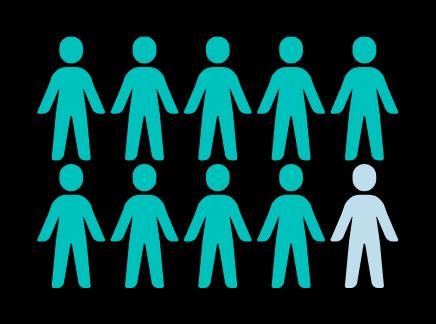
About 9 in 10 Asian Americans have personally experienced at least one incident of discrimination.
Source: PEW Research Center Survey of Asian American adults conducted July 5, 2022 - Jan. 27, 2023

Despite the surge in instances of anti-Asian hate during the COVID-19 pandemic, it's essential to recognize that such discrimination is not a recent phenomenon.
Dating back to the 1882 Chinese Exclusion Act, to the denial of naturalization rights until the 1940s, to the internment of Japanese Americans during World War II, and to the prejudice faced by Muslims, Sikhs, and South Asians after the September 11, 2001 attacks, Asian Americans have consistently encountered discrimination and marginalization, often being perceived as outsiders throughout their extensive history in the United States.
If
• Contact the police right away (911)
⚬ If you or someone else is in immediate danger, facing a medical emergency, or witnessing a crime in progress
⚬ If you observe suspicious and/or threatening behavior or activity that may indicate criminal intent
• Get medical attention (if needed)
• Save/document all evidence
⚬ Take photos and write down important information
⚬ Evidence includes graffiti, vandalism, license plates, etc.
If you are a hate
victim, you should:
• Get the names, addresses, phone numbers, and emails of witnesses
⚬ Try to get a description from any eyewitnesses of the suspect(s) or vehicle(s) involved
• Contact community organizations in your area that respond to hate/incident crimes
• Report the incident by phone or online
If you’ve experienced a hate incident, you should:
• Take photos & document incident
• Get the contact information of witnesses
• Try to get a description from any eyewitnesses of the perpetrators or vehicle(s) involved
• Contact community organizations in your area that respond to hate/incident crimes
• Report the incident
In the face of unfortunate incidents of police violence, knowing your rights when interacting with law enforcement empowers you to protect yourself and advocate for justice:
• If you initiate the contact with police, you can end the contact at any time.
• Starting the conversation by explaining that you have had negative past experiences with the police will help officers to better understand your point of view.
• You can request a supervisor at anytime.
• It’s your right to record your contact with police.
It’s important to remember that while you have these rights, specific laws and regulations may vary by jurisdiction. Remaining calm and cooperative (while still asserting your rights) during interactions with the police can often lead to smoother outcomes.

Xenophobia is a fear or hatred of...
A. People who dress differently
B. People whose views are different
C. Foreigners and strangers
D. People carrying infectious diseases such as Covid-19

Xenophobia is a fear or hatred of...
A. People who dress differently
B. People whose views are different
C. Foreigners and strangers
D. People carrying infectious diseases such as Covid-19

A. Call out racist language
B. Celebrate other cultures and honor differences
C. Report bullying and attacks
D. All the above

A. Call out racist language
B. Celebrate other cultures and honor differences
C. Report bullying and attacks
D. All the above
• Intervention methods developed by Right To Be, an organization that works to combat harassment
• Distract, Delegate, Document, Delay, and Direct Intervention can be used to support someone who’s being harassed, to emphasize that harassment is not okay, and to demonstrate that we have the power to make their community safer.
Source: Right To Be
Distraction is a subtle and creative way to intervene. Its aim is simply to derail the incident of harassment by interrupting it. The keys to good Distraction are:
• Ignore the person who is harassing and engage directly with the person who is being harassed.
• Don’t talk about or refer to the harassment that’s happening. Instead, talk about something completely unrelated.
Source: Right To Be
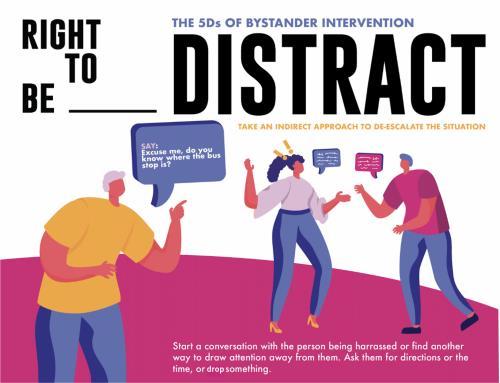
Source: Right To Be
Delegation is asking a third party for help with intervening in harassment. The keys to Delegation are:
• Look for a Delegate who is ready and willing to help. Often, a great choice is the person right next to you.
• When you Delegate someone to help you, try to tell them as clearly as possible what you’re witnessing and how you’d like them to help.
Source: Right To Be
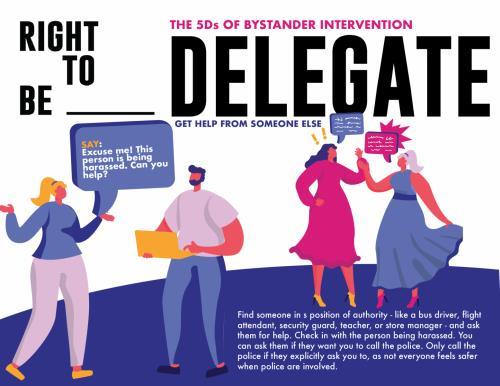
Source: Right To Be
Documentation involves either recording or taking notes on an instance of harassment. It can be really helpful to record the incident, but there are some keys for safely and responsibly documenting harassment:
• Assess the situation. If no one is helping the person being harassed, then use another one of the 5 D’s. Recording someone’s experience of harm without ensuring they’re receiving help can create further trauma for them. If someone else is already helping out: assess your own safety, and if you are safe, begin documenting.
• ALWAYS ask the person who was harassed what they want to do with your recording and/or notes. NEVER post it online or use it without their permission.
Source: Right To Be
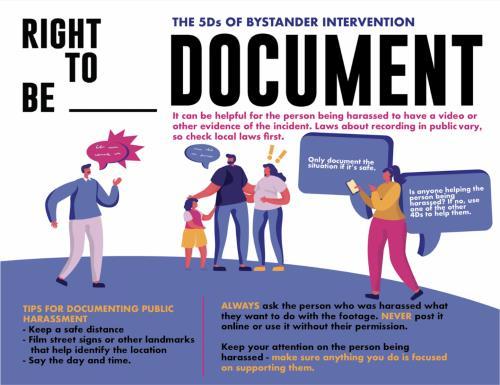
Source: Right To Be
Even if we can’t act in the moment, we can still make a difference for someone who’s been harassed by checking in on them after the fact. Many types of harassment happen in passing or very quickly, and it’s not always possible we’ll have a chance to intervene in another way.
But we don’t have to just ignore what happened and move on. We can help reduce that person’s trauma by speaking to them after an instance of harassment.
Source: Right To Be
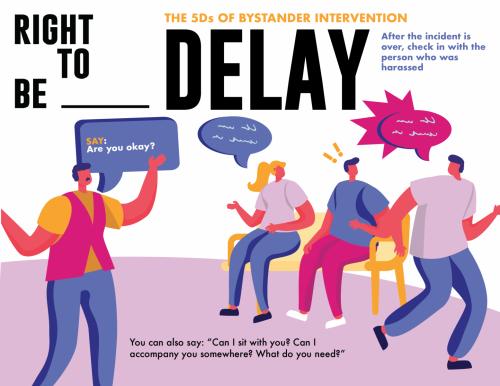
Source: Right To Be
Sometimes, we may want to respond directly to harassment by naming the inappropriate behavior confronting the person doing harm.
Use this one with caution, because Direct intervention can be risky – the person harassing may redirect their abuse towards the intervening bystander, or may escalate the situation in another way. The first key to Direct intervention is to assess the situation before you decide to respond, by asking yourself the following questions:
Source: Right To Be
• Are you physically safe?
• Is the person being harassed physically safe?
• Does it seem unlikely that the situation will escalate?
• Can you tell if the person being harassed wants someone to speak up?
If you can answer yes to all of these questions, you might choose a direct response.
The second key to Direct intervention is to keep it short and clear. As tempting as it may be, avoid engaging in dialogue, debate, or an argument –since this is how situations can escalate.
Source: Right To Be

Source: Right To Be

• Speak out against hate and intolerance
• Have community rallies to support victims
• Offer support and help to victims
• Ask public officials to speak out against hate crimes

• Speak out if you witness a hate crime or incident
• Report the hate crime or incident
• Consider taking part in a training about hate
• Advocate for awareness in your workplace
Stop AAPI Hate’s online reporting form for hate acts
California vs Hate’s online reporting portal for hate crimes and hate incidents
lapdonline.org/file-a-police-report
Los Angeles Police Department Community Online Reporting Service (CORS)

Are all bias incidents considered hate crimes?
A. Yes
B. No

Are all bias incidents considered hate crimes?
A. Yes
B. No
In many instances, there can be verbal harassment or discrimination against someone based on their identity, but the incident does not involve an underlying crime, such as aggravated harassment, physical attack, a threat of attack, or property damage.

Does law enforcement take reports for hate crimes?
A. Yes
B. No

Does law enforcement take reports for hate crimes?
A. Yes
B. No
Every law enforcement agency tracks hate crime data and the department is required to post that information on a specified website on or before July 1 of each year.

Does the LAPD take reports for hate crimes or hate incidents?
A. Hate Crimes
B. Hate Incidents
C. All the above

Does the LAPD take reports for hate crimes or hate incidents?
A. Hate Crimes
B. Hate Incidents
C. All the above
The LAPD’s Community Online Reporting System (CORS) has been updated to include a ‘hate incident’ category, along with hate crimes and other non-emergency issues



